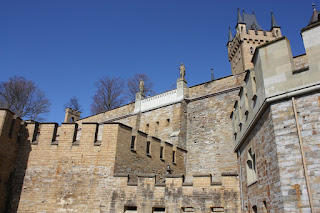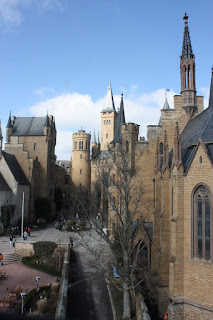We, Kathy and Richard, went to Bayreuth for a long birthday weekend. (Richard's birthday is the day after Germany's national holiday commemorating reunification.) Bayreuth is only an hour and a half from home, but we had never been there together. (Richard was there once many years ago.) The weather forecast was for rain, but there are enough museums and palaces and monasteries to visit so that you can spend most of your time for an entire weekend indoors.
When we got to Bayreuth, however, we were surprised by the beautiful weather. Sunny and warm. So we changed plans and went to the Landesgartenschau (Bavaria's state garden show). Since Bayreuth is the home of the annual Wagner Festival, some of the plantings had the theme "Music for your eyes"
And since Bayreuth is in Bavaria, which is known even in Germany for its beer, one of the gardens had hops climbing up wires.
And since it was Richard's birthday trip, some of the gardens were color-coordinated with his shirt.

When we got to Bayreuth, however, we were surprised by the beautiful weather. Sunny and warm. So we changed plans and went to the Landesgartenschau (Bavaria's state garden show). Since Bayreuth is the home of the annual Wagner Festival, some of the plantings had the theme "Music for your eyes"
And since Bayreuth is in Bavaria, which is known even in Germany for its beer, one of the gardens had hops climbing up wires.
And since it was Richard's birthday trip, some of the gardens were color-coordinated with his shirt.
After we got about half way through the garden show (about a mile from the entrance to a different entrance), we were only about another mile from the Old Palace. This requires a little background information. Frederick the Great was the king of Prussia from 1740 until 1746. He is the king who enjoyed the arts, composed music, and had the palace Sanssouci built. His favorite sibling was his older sister, Wilhelmine. We saw a painting of the two during a tour of Schloss Charlottenburg during our recent visit to Berlin.
Wilhelmine was originally intended to marry the son of King Charles II of Great Britain. Even though Wilhemine's mother was the sister of King Charles II, the marriage couldn't be worked out, so Wilhemine married Frederick, Margrave of Brandenburg-Bayreuth. Being the sister of the King of Prussia, Wilhelmine and her husband Frederick did much to transform Bayreuth into a royal residence. The had the of the great Bayreuth opera house rebuilt (which is now a UNESCO World Heritage Site); had a second, new opera house built; had the Bayreuth palace rebuilt; all in the so-called Bayreuth Rococo style of architecture as it is known even today. (By the way, the pair also founded the University of Erlangen.)
Wilhelmine also had a summer residence built, called the Ermitage. Although the Old Palace was built in 1715 by Margrave Georg Wilhelm as the central feature of a court hermitage, Wilhelmine enlarged it and transformed it into a palace. She spent much of her time there painting. There is a grotto near the entrance; a small room covered in stones and filled with fountains. Our guide put a cone-shaped crown on the central fountain, and you can see it supported on a jet of water just below the Prussian eagle in the picture.
The new palace is a kind of orangery at the end of a large pool. The main building is called the Temple of the Sun, and on the top of the dome there is a golden statue of Apollo in his sun chariot pulled by four horses as he crosses the world and fills it with his light.
The outer surface of the building is covered in colored stone and glass, and it sparkles in the sun light.
After finishing our tour of the Ermitage, we walked back to the garden show and saw the rest of it. This took most of the day, but we had time afterwards to go into Bayreuth and visit the Richard Wagner Museum. There were three buildings to visit, and they were each interesting, so we didn't spend much time in any one of them. The first was a new building dedicated to his operas. On the bottom floor were original costumes from performances going back to 1876 when the Festspielhaus opened. You could see how the interpretation of the operas has changed, and the costumes along with it. There was also a wall of models of the stage sets. Upstairs is a room showing video from some famous productions.
The second building is Wahnfried, the house where Wagner lived with his wife Cosima and their children. Their Wahnfried library and a grand piano are the main attractions in the living room. The library was saved in 1944 when a bomb destroyed the living room because it had been taken to caves in the mountains of the Frankische Schweiz (near where we live). The library contains the classics and books by Schopenhauer. I thought it interesting that no work by Karl Marx was included, because Wagner was a socialist who was banned from Dresden for his political views. The piano was saved because it had been moved into the entrance hall for a performance. In the basement is the Dresden Library, which Wagner used as collateral for a loan of 500 talers. Wagner never repaid the loan, and the library was taken to Leipzig. Somehow it survived the destruction of the second world war. It was nearly forgotten until a biographer of Wagner tracked it downs sometime later.
The third building was never seen by Wagner. It was built by his son, Siegfried, after Wagner died. Siegfried and his wife, Winifred, lived there until Siegfried died in 1930, but Winifred continued to live there until her death in 1980. The Siegfried House, as it is called, contains information on the connection between the Nazis and Wagner's operas. There is even video of Winifred receiving Hitler at the house, and information on their friendship. There is more information on the lasting consequences on the connection between the Nazis and Wagner's work, and how it affected the productions at the Festspielhaus.
The next day we went to the Waldsassen Abbey, which is a Cistercian nunnery and formerly a Cistercian monastery. It was built between 1128 and 1132, but it was almost completely burned down in the Thirty Years' War (1618 to 1648). It was rebuilt in the Baroque style after 1681. The monastery was dissolved and secularized under by Napoleon in 1803, and was used as a factory for making cotton. In 1863, the remains of the old abbey were bought by Cistercian nuns, who opened an institute for the education of girls. Back in 1724, a library was built in late Baroque and early Rococo style.
There are 10 life-size figures seem to be supporting the balcony. Each one of the figures is an allegory, and although the representation is still under some contention, the consensus is that they are fools representing human vices. In the close-up picture, the vain mocker is portrayed. The artistry is really remarkable. Sometimes the expression on the face of a figure is different when viewed from the front than when viewed from the side!
To complete the monk's theme for the day, we took a tour of a brewery museum. The Maisel Brewery constructed a new factory recently, and the old brewery was preserved as a museum.

In the restaurant on the wall was a family tree of beers and some witty sayings, like referring to beer as a "hops smoothie".
The last morning was spent touring the new palace in town (as opposed to the new palace in the Ermitage). There were lots of beautiful rooms, but my personal favorite was the room lined with walnut walls and a walnut floor. I have never seen so much beautiful walnut in one room before!
We returned home after lunch. As we waited at the train station in Bayreuth, we could see the Festspielhaus in the hill just outside of town, where the opera festival takes place every year. I have been trying to get tickets every year for 10 years now, but it is so popular that it could take a few more. But I'm optimistic that I will get tickets some year, so I'm waiting to visit the Festspielhaus until then.



!["Frederick the Great as a child with sister [Friederike Sophie] Wilhelmine" (A. Pesne, oil on can. 1720s?). Princess Wilhelmine was Margravine of Brandenburg-Bayreuth. In 1756, an Austrian regiment passed through Bayreuth, en route to the wars, and its officers dined with the Margravine. "What do you think of the war, and what will become of the King of Prussia?" she asked. One said that he believed the king was "all f---d up." "That would displease me somewhat" she replied, "he's my brother.":](https://s-media-cache-ak0.pinimg.com/564x/49/59/6a/49596a99916b49f55357a672b86a9ca6.jpg)






















